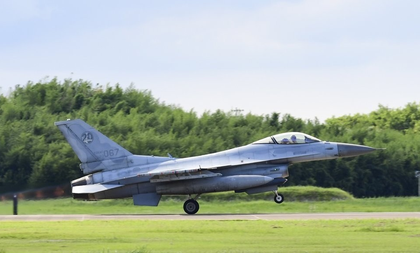Pilots escape after South Korean KF-16 fighter jet accident in Alaska
By IANS | Updated: June 11, 2025 13:03 IST2025-06-11T12:59:51+5:302025-06-11T13:03:31+5:30
Seoul, June 11 Pilots made an emergency escape following an accident involving a South Korean KF-16 fighter jet ...

Pilots escape after South Korean KF-16 fighter jet accident in Alaska
Seoul, June 11 Pilots made an emergency escape following an accident involving a South Korean KF-16 fighter jet taking part in the US-led multinational Red Flag air exercise in Alaska, the South's Air Force said on Wednesday.
The two pilots ejected themselves from the double-seat fighter after an emergency situation occurred at around 4 p.m. Tuesday (US time) during takeoff from Eielson Air Force Base, according to the Air Force.
In a separate statement, the US 354th Fighter Wing confirmed the incident occurred on base within the fence line of the Eielson Air Force Base, while departing the prepared surface.
The scope of the aircraft damage and the circumstances leading to the accident were not immediately known.
"The two pilots visited a US Army hospital and are currently recovering. No major injuries were reported other than minor burns and lacerations," the Air Force said in a notice.
The KF-16 fighter, which was partially damaged due to a fire, remains parked on the grass near the runway, it added.
The Air Force plans to dispatch a team to probe the accident and carry out emergency maintenance later in the day, amid efforts to determine the exact cause of the accident under close cooperation with the US side.
The incident is the first known accident involving a South Korean fighter jet overseas, Yonhap news agency reported.
Launched in 1975, the Red Flag-Alaska exercise is designed to provide realistic training in a simulated combat environment, according to the US military.
South Korea has deployed fighter jets to the exercise since 2013. This year, the South's Air Force mobilised 11 aircraft, including the KF-16 fighter and the KC-330 transport plane, and some 100 airmen.
Earlier on April 20, the Air Force had grounded nearly all of its aircraft after a KA-1 light attack aircraft accidentally released two gun pods and empty fuel tanks.
The aircraft taking part in nighttime drills over Pyeongchang, about 125 kilometres east of Seoul, jettisoned the parts in a mountainous area. No casualties or property damage had been reported.
In response, the Air Force had decided to impose flight restrictions on all of its aircraft, excluding those that conduct reconnaissance operations or were on emergency standby.
Disclaimer: This post has been auto-published from an agency feed without any modifications to the text and has not been reviewed by an editor
Open in app